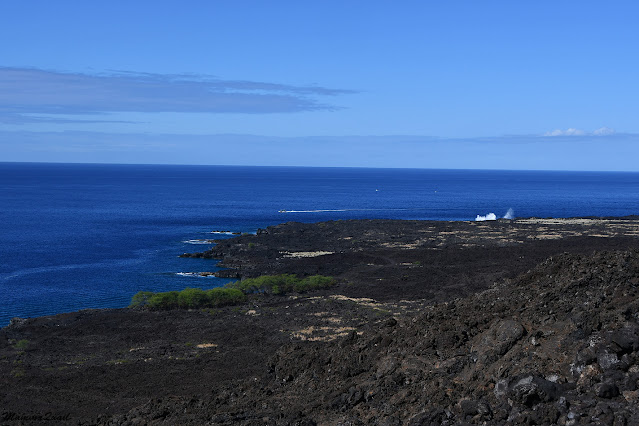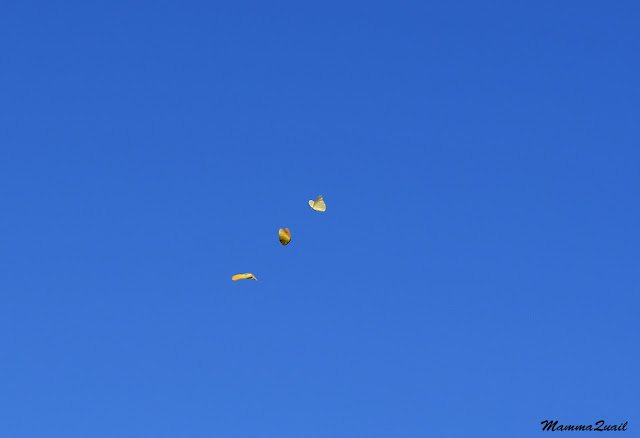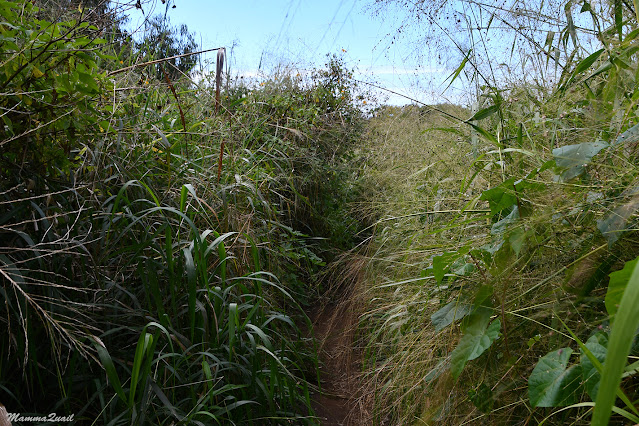Date: March 19, 2022
Place: Mariposa Grove of Giant Sequoia, Yosemite National Park, California
Coordinates: 37.506950, -119.630043
Length: 10 miles
Level: moderate to strenuous
Last a coupe of weeks ago we had a visitor from overseas. We didn't need to direct him toward Yosemite National Park - he already had it on his itinerary. His original plan was to go there on his own but since transportation turned out to be an issue and since it has been a while for us since we've been there ourselves (an even longer time for Pappa Quail), we decided to go all together. We stayed for three nights in Mariposa and toured a different part of the open areas of the park each day. On our first day we did sightseeing and hikes in the Yosemite Valley, and on the second say we entered the park from the south entrance and went to see the Mariposa Grove of Giant Sequoia.
It is a few years now that Mariposa Grove isn't accessible to private vehicles and visitors need to park at the welcome plaza and take a free shuttle bus from there. The shuttle bus is active only in season and our recent visit there was out of season so we resorted to walking the two miles distance between the welcome plaza and the base of the Mariposa Grove.
 |
| Our hike as captured by my GPS |
Right by the parking lot, the elder chika found a cool bird - a white-headed woodpecker, busy looking for bugs. The woodpeckers are year-round birds there and this time of year they are getting ready to nest. We saw many woodpecker nesting holes on this hike, but no activity in or near them yet.
 |
| White-headed Woodpecker, female |
The 2-miles connector trail passes through forested areas and some open areas as well. It was sad to see so many trees that looked sick or were dead. The invasive boring beetle, combined with the recent droughts had wreaked havoc in the California forests. It isn't news anymore, and it is heart breaking to see the sick forests. In my mind I still expect to see it pristine when I go to the Sierra Nevada.
We were walking on the south-facing slope and there wasn't much snow cover on the trail. On the other side, the north-facing slope there was still considerable snow cover on the ground. On the open areas we could also see the looming clouds - the forecast for the day was rain.
I was surprised at how many people were walking this trail. It was actually a challenge to get trail photos that didn't include humans. I thought that the cold and the forecast of rain would deter people but I guess that just like us, they chose this day to be in the forest rather than to go to where grand views matter.
The only wildflowers that I could see were the manzanita blooms. Sill I was the slowest person in our little group. On recovery from an injury, I was taking it slow and easy. Thus it happened that when the elder chika and Pappa Quail noticed the Douglas squirrel on the offside, I was the closest one to it and my photo came out the best.
 |
Douglas Squirrel
|
They didn't linger on that squirrel for long though. A few steps further up the trail they saw a chipmunk and gave it due attention.
 |
| Long Eared Chipmunk |
When we arrived at the base of the Mariposa Grove we found that there are massive renovations going on. There was no actual work happening when we were there, but large areas were fenced off and there were piles of building materials everywhere. A new visitor center and a new display are being built there. It should look really nice when done.
There were wood benches near the closed off area and we sat down to have some snacks. A large raven was strutting around, like a ranger checking out the park visitors. The elder chika photographed the raven.
 |
| Raven |
Our day was very winter like but spring was already in the air, certainly for the squirrels who were chasing each other fervently.
 |
Douglas Squirrels
|
Our main goal for the day was to see the Grizzly Giant - the biggest sequoia tree in Yosemite National Park. Me and my family have been there numerous times but our young visitor has never seen the giant trees and we couldn't let him go back home without seeing them.
The direct trail to the Grizzly Giant was blocked off for renovations so we started up the longer arm of the giants loop. Soon enough we came upon the first giant sequoia, which was a very impressive tree but a small one relative to the Grizzly Giant.
 |
Giant Sequoia, Sequoiadendron giganteum
|
There were other signs of spring all over the place. Lots of new germination in the exposed ground where the snow receded, for example.
I was delighted to see yet another flower besides the manzanita, and a ground flower too - a wild strawberry! There was only one flower, but still.
The construction bypass is the trail we used to hike when coming back down from the upper grove. Now we were aiming directly to the Grizzly Giant. While sequoia trees are the most striking beings in their forest, they are not the most common conifers there. There were plenty of ponderosa pines, firs, and cedars too. It was encouraging to see nurseries - patches of young trees growing to fill in the spaces left by the dead trees.
The saying is that trees die upright. For many it is true, and it is a sad sight to see a stand of upright and very dead trees. When a tree falls down however, the hole in the ground left by its uprooting becomes a receptacle for water and a nursery for algae and insect larvae.
Turning around the curve we came within view of the Grizzly Giant. It was impossible to miss even from a distance - so huge it looked relative to the nearby trees, which were not small by any standard either.
I sent off everyone to approach the Grizzly Giant while I stayed at the far view point so I could photograph them as tiny human specks beneath the giant sequoia. While I was taking the photos It started to rain. The rain very quickly changed to hail, and soon the trail was covered with tiny ice balls.
 |
| Hail |
In the past I had laid down on the ground beneath the tree in order to capture it base to canopy. I wasn't about to do it today so I moved as close as I could while fitting the image of the Grizzly Giant in a single frame.
 |
| The Grizzly Giant |
It seemed to me that by the time it took me to get closer to the giant tree the number of people below it had dwindled considerably. I assumed the hail prompted them to start on their way back. We on the other hand, started uphill toward the Upper Grove. On our way there the hail changed to snow and everything turned very quiet all of a sudden.
For our visitor from overseas it was the first time seeing falling snow and he was utterly delighted by that experience. Light fresh snow started accumulating on the vegetation and on us. Less so on the trail - the exposed trail was warmer and the falling snow melted on contact with the trail ground. The large snow patches we crossed were of leftover old snow.
The snow's transformation of the scenery was magical. It felt like we had stepped through the wardrobe right into Narnia. I was looking for Mr. Tumnus to come hopping down the trail too.
We were all alone on the trail now. There were a few more people in the higher area of the Mariposa Grove, we did see them later on, but for a long while it looked as if we had the mountain all to ourselves.
We hiked most of the way up on the wide dirt road where the tram usually goes in summer. When we reached the Clothepin Tree, a giant sequoia with a naturally burnt tunnel at its base, we took the turn directly to the Mariposa Grove Cabin.
 |
| Clothepin Tree |
We knew there would be precipitation that day and we came prepared. As soon as it started to rain we wrapped ourselves in plastic ponchos. We kept these on for the rest of the hike. I thought that the ponchos gave is a fitting look of forest elves.
One of the hard sights along that trail was the area of fire devastation which left so many trees damaged or dead.
Manzanita bushes in their spring bloom where quickly covered with snow. It's a good thing that their flowers are bell-shaped, facing down.
 |
Manzanita sp.
|
We reached the Upper Grove and made our way around to the cabin. I was hoping that the cabin would be accessible because we all wanted a food break. The cabin was closed shut but the snow had ceased, so we found a snow free area on the stairs leading to the cabin and we sat down to rest and eat. I noticed the fire hydrants that were placed in the Upper Grove. I don't remember seeing them in my last visit. I may have simply missed them, or maybe they're a new addition in effort to combat the forest fires that are so common in California these days.
I took a photo of the cabin from a distance, showingit dwarved by the giant sequoia trees around it. There was a lot more snow around the Upper Grove, most of it old, leftover snow.
 |
Mariposa Grove Cabin
|
There are numerous trail loops around the Upper Grove, many of them we've hiked in previous visits, including the trail up to Wawona Point, the top of that mountain. It was pointless to hike up to the top on this very cloudy day, and we did have a limited time to get down because off the additional trail we needed to walk to get back to the welcome plaza. We therefore didn't go on the Guardians loop to visit any of the other landmark sequoia trees but started directly downhill. The snow resumed and for most of the way down I kept my camera protected under my plastic poncho.
 |
Giant Sequoia, Sequoiadendron giganteum
|
We came across a few people on the way down. Most of them were also on their way back. At the bottom the snow changed to rain, then stopped altogether. The light snow that fell previously was already melting. On the way out on the connector trail, we did came across a sudden wave of incoming visitors. We were very surprised at that because although the rain had subsided, it was getting late and much colder. I couldn't imagine how the new visitor would make it in as far as the Grizzly Giant and back in daylight. I especially worried about families who hiked in with little kids with them, most appearing too lightly dressed for the wintery conditions. I didn't say anything of course, it was their business and I assume that once it got too cold and dark they would turn around whether they had reached the giant trees or not.

As we passed the open area again I took another look at the hill south of us. the cloud looked like it settled right on top of that hill and wisps of cloud or fog connected the ground with the very gray sky.
We neared the exit of the trail where the mostly conifer forest changed to a mix of conifers and broad leaf trees. The cloud cover darkened the day much earlier than sunset time and still there were people heading out to the Mariposa Grove. I hoped they'd make it in in time to see the giant trees and out while they could still see their way.

Another Douglas squirrel was ushering us out of its forest. The forest was its home, we were merely transient visitors.
 |
Douglas Squirrel
|
The rain resumed when we were driving out of the park. It was a very good day in Yosemite, and we hiked the perfect trail for that day's weather and got to see the sequoia grove while wearing its festive white.
On the following day it was as if the snow was but a dream -it was cloudless and warm, and we had planned to visit a part of the park where it would be really difficult to get to without a private vehicle - the Hetch Hetchy Valley.

































































